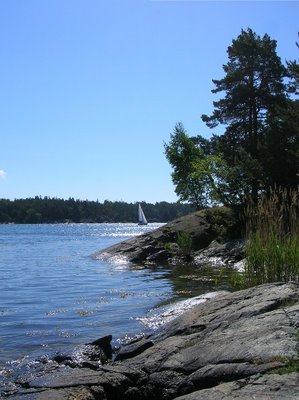 Old Man Winter is back.
Old Man Winter is back.With the first of November comes the first of the winter snowfall. The last of the colorful fall leaves are dropping to the ground, the puddles are icing up, and all the historic vessels in Stockholm are tarped up and downrigged for the season.
 This morning a fine swirling flurry is dusting the city and providing that thrill that comes with the 'first snow'.
This morning a fine swirling flurry is dusting the city and providing that thrill that comes with the 'first snow'.
Of course, for me, it is also a reminder of how bloody far behind I am with this blog. My next post was supposed to be about my Midsommar holiday adventures sailing in the Stockholm archipelago--yeah, the 21st of June. I am waaay behind.

The Thisbe moored off a wild onion-covered islet in the Baltic.
Then there was that month of driving around Sweden, Denmark and Norway seeing all kinds of things from the wreck of the Kronan to the Norwegian fjords.
 A few of Kronan's guns.
A few of Kronan's guns.
 One of the Norwegian fjords.
One of the Norwegian fjords.
Right on the heels of that big trip I was back in Denmark to sail the Danish Straits on Ole's (my Danish ropemaker friend) tubby little traditional Dutch-design boat, Havhesten...
 Ole's Havhesten. You may recall her from the "Havhesten" post from last May.
Ole's Havhesten. You may recall her from the "Havhesten" post from last May.
 The bow of the swift Viking ship replica Sif Ege.
The bow of the swift Viking ship replica Sif Ege.
...and then sailing on two Viking ship replicas. Now that's real blog material!

And the largest Viking ship replica in existence, Havhingsten fra Glendalough.
However, as eager as I am to tell you all about these adventures (with plenty of photos of course), research demands at the Vasa Museum and Stockholm University as well as the everpresent scramble for funding have put me far behind schedule on the blog. Terribly sorry. My apologies to my loyal readers.
But fear not, good things are on the way as soon as I finish my grant applications, document a few hundred more of Vasa's rigging blocks in collections storage, and finish a university paper.
So 'stand by and prepare to take on tales'.
Wow! It's a near white-out out there now! I think this will be a good, deep, Scandinavian winter.
 If you are looking for a little nautical entertainment, I highly suggest visiting the Götheborg III website if you have not already done so. The site features dozens of short films made by the ship's onboard videographer who has been covering the entire voyage from Sweden to China. Plenty of both placid and petrifying sailing, nasty gales in the Indian Ocean, and wonderful welcome parties in Spain, Brazil, and Shanghai--all with plenty of cannon firing fanfare.
If you are looking for a little nautical entertainment, I highly suggest visiting the Götheborg III website if you have not already done so. The site features dozens of short films made by the ship's onboard videographer who has been covering the entire voyage from Sweden to China. Plenty of both placid and petrifying sailing, nasty gales in the Indian Ocean, and wonderful welcome parties in Spain, Brazil, and Shanghai--all with plenty of cannon firing fanfare. 













































